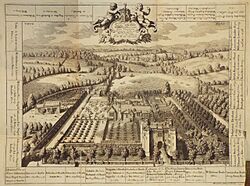Boarstall Tower facts for kids
Quick facts for kids Boarstall Tower |
|
|---|---|
| Near Boarstall, Buckinghamshire in England | |
 |
|
|
Shown within Buckinghamshire
|
|
| Coordinates | 51°49′24″N 001°05′44″W / 51.82333°N 1.09556°W |
| Type | moated gatehouse |
| Site information | |
| Owner | National Trust |
| Open to the public |
Wednesday afternoons |
| Site history | |
| Built | 1312 |
| In use | 1312-Unknown |
Boarstall Tower is an amazing old building from the 1300s. It's a moated gatehouse, which means it's a strong entrance building surrounded by water. You can find it in a place called Boarstall in Buckinghamshire, England. Today, it's looked after by the National Trust, along with its beautiful gardens.
Before March 2020, the National Trust used to offer tours of the tower on Wednesday afternoons. The tower was closed for a while during the Covid pandemic. However, it has since reopened for special visits on certain dates during the summer.
Contents
History of Boarstall Tower
The Legend of the Wild Boar
A long time ago, there's a legend about how Boarstall got its name. King Edward the Confessor supposedly gave some land to one of his brave men. This was a reward for killing a huge wild boar that was causing trouble in the nearby Bernwood Forest.
The man built a large house on this land. He called it "Boar-stall," which means 'Boar House' in Old English. This name was a way to remember the fierce beast he had defeated. The legend also says that the man, named Neil, received a horn from the dead boar. It was believed that whoever owned this horn would be the true lord of the manor of Boarstall.
Early Records and the Gatehouse
Records from 1265 show that the owner of the Boarstall manor had an important job. They were the official keeper of the Bernwood Forest. This suggests a strong connection to the old legend about the boar.
In 1312, the manor was made stronger with a new defensive gatehouse. This gatehouse was very big and grand for its time. The main house was taken down in 1778, but the gatehouse still stands today. It looks much like it did hundreds of years ago.
Boarstall Tower in the English Civil War
During the English Civil War, Boarstall Tower became a military base. King Charles I used it as a garrison because he controlled the nearby village of Brill.
- In 1643, Brill fell to the Parliamentarian forces.
- The garrison at Boarstall also fell.
- While the manor at Brill was destroyed, Boarstall's strong gatehouse was saved.
- It was then used by John Hampden's Parliamentarian soldiers.
- From Boarstall, they could attack Royalist forces in Oxford, which was about 8 miles away.
In 1644, Hampden's men left Boarstall to fight elsewhere. The Royalists, led by Colonel Henry Gage, took the house back. It's said that Gage used his cannons so powerfully that Lady Penelope Dynham, who lived there, had to escape in disguise. Gage left a small group of soldiers to protect the house.
Later Battles and Surrender
In May 1645, the Parliamentarian forces attacked Boarstall again. This time, they were led by Sir Thomas Fairfax, but they didn't succeed.
The next year, in 1646, Fairfax returned. After an 18-hour siege, the house was given up to him on June 10th. The Dynham family, who owned Boarstall, later got their property back. They were lucky to have relatives who were close to Oliver Cromwell, a powerful leader at the time.
The Boar's Horn Today
In 1806, a book called Magna Britannia mentioned that the owner of the manor, Sir John Aubrey, 6th Baronet, had a large horn. The book described it as: "of a dark brown colour, variegated and veined like tortoise-shell. It is two feet four inches in length, on the convex bend, the diameter of the larger end is three inches; at each end it is tipt with silver, gilt, and has a wreath of leather, by which it is hung about the neck".
Boarstall Tower was later given to the National Trust. This gift came from a kind person named Ernest Cook, who also started the Ernest Cook Trust.
See also



